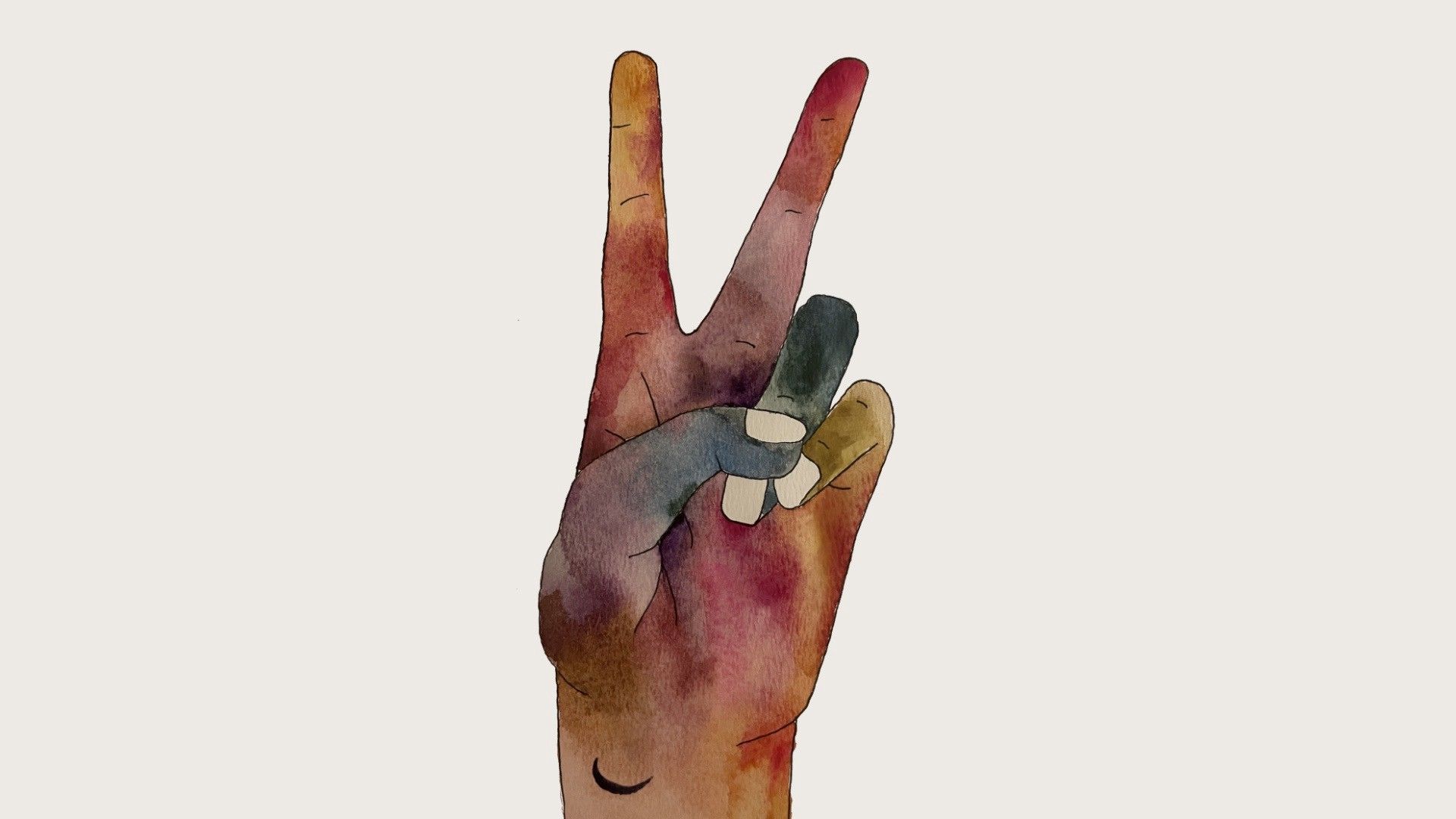1 Quirky Habit I Invented That Has Been Surprisingly Powerful
Don’t knock it till you’ve tried it.

About a year ago, I started drawing a half-circle on the inside of my wrist. I had no idea that this small and admittedly quirky habit would end up having such an impact on my life and mindset.
It started after reading about the 21-Day No-Complaint Experiment on Tim Ferris’ blog.
The experiment was designed by Will Bowen, an American minister, who gave everyone in his congregation a simple purple bracelet, challenging them to go for 21 consecutive days without complaining. Each time they complained, they had to switch the bracelet to their other wrist and start again from day 0.
A simple experiment that turned out to be hugely popular and effective. To date, more than 14 million people all over the world have used the bracelets.
I’ll explain what the bracelet has to do with the drawing on my wrist, but first, let me talk about why these two things can have such a powerful impact on you too.
We’re hardwired for negativity
Overall, I’m a positive and happy person, yet I can often get stuck in a loop of negative thinking. Annoyed about having to wait somewhere, catastrophizing about something going wrong on a project, complaining about a colleague or a boring call I have to dial in for. I’m aware it’s happening, but it’s difficult to snap out of it.
Did you know that 60–70% of our thoughts are negative? There was an interesting study by Cornell University, in which scientists found that firstly 85% of what we worry about never happens. Secondly, with the 15% of the worries that did happen, 79% of the subjects discovered that either they could handle the difficulty better than expected or that it taught them a lesson worth learning.
The conclusion is that 97% of our worries are baseless and result from an unfounded pessimistic perception.
As humans, we’re hardwired to prioritize the negative. This is called the Negativity Bias, referring to our tendency to attend to, learn from and use negative information far more than positive information.
We can’t help it.
From an evolutionary perspective, paying attention to bad, dangerous, and negative threats in the world was literally a matter of life and death. In prehistoric times, those who were more attuned to danger and paid more attention to the dangerous things around them were more likely to survive. Our primitive brains still function this way, even though our societies have evolved.
The point is, you need to put conscious effort into truly valuing all the good and positive aspects of your life so that you are not overpowered by the negative.
Key word here is conscious. Recognizing and replacing negative thoughts takes awareness, discipline and practice — and that’s where a visual cue comes in.
The power is in the inescapable, visual reminder
You can tell yourself you’ll complain less, but we all know how easy it is to forget our good intentions the moment we step out of the door.
You need a regular reminder. A trigger that will pull you out of your head when you get stuck.
I’ve previously written about how our visual system is the strongest lever by which we can shift our state of mind.
Visual cues are the most powerful, as described by James Clear in his bestselling book on habit building, Atomic Habits:
“Given that we are more dependent on vision than on any other sense, it should come as no surprise that visual cues are the greatest catalyst of our behaviour. For this reason, a small change in what you see can lead to a big shift in what you do. Creating obvious visual cues can draw your attention towards the desired habit.”
The beauty of the bracelet in the No Complaint Experiment is that it’s something that is with you wherever you go.
I’m too fidgety, so I’d lose a bracelet after a day. I thought to myself— “what else can serve as a non-escapable visual cue throughout the day?”
A tattoo? Too permanent.
Drawing on my wrist like a 5-year-old? Perfect.
It’s all about retraining our brain
I started by drawing on my wrist every morning and reminding myself throughout the day to pay attention to any negative thinking, like complaining, worrying, gossiping, (self)-criticizing, catastrophizing, etc.
The second I catch myself thinking these kinds of thoughts, I look at my wrist and tell myself to put things in perspective. To lighten up. To be kinder. To let go of things that are out of my control.
Sometimes, I even force myself to smile. It sounds nutty, but it works. Try it. Imagine you’re smiling without smiling. Can you feel the muscles in your face? It’s scientifically proven that simply moving your facial muscles in a way that mimics a smile can trick your brain into a more positive state.
Often, negative thoughts would come from a conversation or interaction with other people. I would have an emotional reaction to something someone has said to me. A glance at my wrist reminds me that I don’t have to feel that way. I can choose whether I take something badly or negatively. As in the Stoic philosophy — if you choose not to be offended by others’ actions, you will not be. Simple as that.
To be clear — my intention is not to be blindly optimistic in every single situation, and I don’t think we need to be ‘happy happy’ all the time. That would be annoying.
It’s more about putting things in perspective and not wasting time on negative emotions. They’ll come up, of course, that’s only natural, but there’s no reason to spend much time and energy on things that are out of our control anyway.
By no means am I succeeding in doing this every time. It’s hard work, and there are weeks where I even forget to do it at all. However, I have noticed that I can catch myself much quicker. I am more aware whenever a negative thought or emotion comes up and will instinctively glance at my wrist. It’s become easier to let go of things, to shrug them off.
Now, am I planning on drawing on my wrist for the rest of my days? I hope not. The idea is that this way of thinking will become hardwired into my brain. Given the beauty of neuroplasticity — the brain’s ability to rewire itself — this practice of shifting things into a positive light will become more and more automatic until, ultimately, I won’t need the visual reminder anymore.
Experiment with your visual reminder
Right now, you might be thinking: “I’m happy for you if this is something you needed, but it doesn’t apply to me. I don’t get stuck in negative thinking. I’m a happy person.”
That might be the case, but I still challenge you, for one week, to see it as an experiment and to pay careful attention to the quality of your thoughts. How often are you complaining about something small? How often are you rolling your eyes? How often are you saying something negative about someone else, judging and assuming the worst? You might be surprised.
You can pick any visual cue you want. It can be a bracelet that you already own. All you need to do is consciously assign this cue the task of reminding yourself to pay attention to your thoughts and shift things in a positive light. It will be challenging the first few days, but you’ll soon notice that it becomes easier, more instant.
Or use my half circle. Sure, it’s a bit quirky to draw on yourself, but if it helps you, why not? No one needs to know. :)
Let me end with this quote from Naval Ravikant, which perfectly encapsulates why I believe this practice is so important:
Your life is a firefly blink in a night. You’re here for such a brief period of time. If you fully acknowledge the futility of what you’re doing, then I think it can bring great happiness and peace because you realize this is a game. But it’s a fun game. All that matters is you experience your reality as you go through life. Why not interpret it in the most positive possible way? Any moment where you’re not having a great time, when you’re not really happy, you’re not doing anyone any favors. All you’re doing is wasting this incredibly small and precious time you have on this Earth.
